Summer has arrived, although you wouldn't know it from the weather here in New York City. New York is beastly hot in the summer and frigid in the winter, but spring and fall are heavenly; of course, they last about two weeks each. Somehow this year, though, we've had springlike weather long after the miasma usually descends. This miasma, in theory, sends wealthy art collectors out of the city to their summer haunts, wherever they might be. I wouldn't know, since my family has always had to work for a living keeping the city running, and we don't get to escape the heat.
And anyway all of that was before widespread air conditioning. Now you barely need to go outside for any reason, and so the art season, which should be winding down for the summer, is in fact still going. I guess it's slowing a bit -- more group shows are on the schedule than usual -- but there's still plenty of new stuff every week.
Jim Wolanin is in the city this month, too, up from Bon Jovi Land, since he was granted a summer residency at the School of Visual Arts. I picked him up outside his studio -- I wasn't able to go up and see his current work owing to Manhattan's post-September 11th armed camp mentality -- and we went crosstown to see what was showing.
We started at McKenzie Fine Art's World without End, a group show on the theme of "iteration." Or infinity, or something. You know I never pay attention to gallery verbiage. Well, this is an interesting show with some very good work in it.
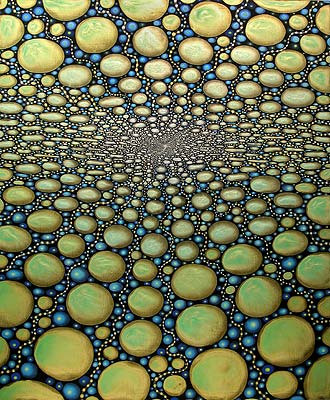 I immediately recognized one of the paintings but couldn't place the artist. I looked over the postcard and the name didn't jump out; on the way home I managed as much as Barbara Nagasomething, because I remembered trying to memorize her name by thinking of a sea snake. It wasn't until I was home that I saw her name on the card: Barbara Takenaga. I saw a number of her meticulous paintings at an opening a couple of years ago where she was showing with Amy Yoes. I really like Barbara's work: It's obsessive and interesting, abstract and yet somehow concrete. There's an area where I tend to really like art, balanced between realism and total abstraction, and Barbara has taken up residence there. I like her colors and the contrast she achieves between different tones. This particular work is more entrancing than usual, too, because -- although it's not clear from the reproduction -- the green ovals are pearlescent and shimmery.
I immediately recognized one of the paintings but couldn't place the artist. I looked over the postcard and the name didn't jump out; on the way home I managed as much as Barbara Nagasomething, because I remembered trying to memorize her name by thinking of a sea snake. It wasn't until I was home that I saw her name on the card: Barbara Takenaga. I saw a number of her meticulous paintings at an opening a couple of years ago where she was showing with Amy Yoes. I really like Barbara's work: It's obsessive and interesting, abstract and yet somehow concrete. There's an area where I tend to really like art, balanced between realism and total abstraction, and Barbara has taken up residence there. I like her colors and the contrast she achieves between different tones. This particular work is more entrancing than usual, too, because -- although it's not clear from the reproduction -- the green ovals are pearlescent and shimmery.
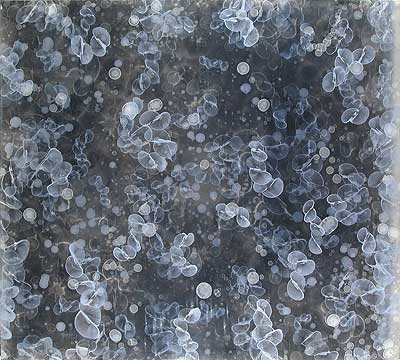 The only other artist I recognized was David Mann, and only because I've seen his paintings in the office at McKenzie every time I've been there. David is one painter who has, as near as I can tell, found what he likes to do and keeps doing it over and over: Little cell-like swirls. Every painting of his is pretty much the same except for color. Blue cells on a dark blue background, pink cells on a brown background, and so on. This one is light blue cells on a background which looks like a photo emulsion but is apparently built up from -- and I quote the painting's online listing here -- "oil, alkyd, acrylic and wax". David's paintings don't move me deeply but they are worth looking at.
The only other artist I recognized was David Mann, and only because I've seen his paintings in the office at McKenzie every time I've been there. David is one painter who has, as near as I can tell, found what he likes to do and keeps doing it over and over: Little cell-like swirls. Every painting of his is pretty much the same except for color. Blue cells on a dark blue background, pink cells on a brown background, and so on. This one is light blue cells on a background which looks like a photo emulsion but is apparently built up from -- and I quote the painting's online listing here -- "oil, alkyd, acrylic and wax". David's paintings don't move me deeply but they are worth looking at.
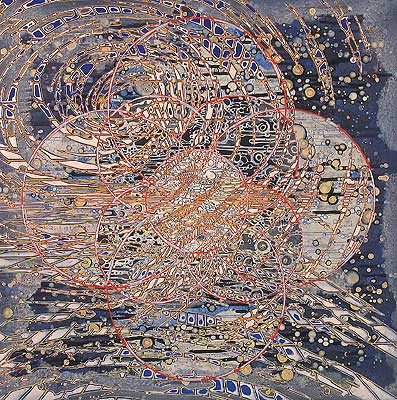 Sara Walker has a good painting on paper. I want to say it's nice without being insulting; it's nice, it's good, it's interesting. I don't want to damn it with faint praise. I'd like to see more by her.
Sara Walker has a good painting on paper. I want to say it's nice without being insulting; it's nice, it's good, it's interesting. I don't want to damn it with faint praise. I'd like to see more by her.
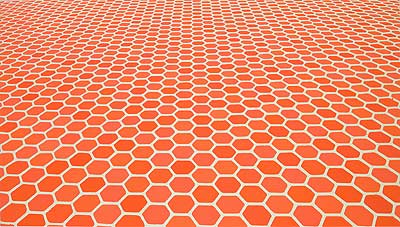 Another Sara, Sara Eichner, has a couple of very neat little paintings where a plane of hexagons marches off into the distance. Jim and I agreed that in large scale they'd be stunning; their small size weakens their impact, but they're still excellent explorations of perspective. They reproduce completely flat but what I appreciate about them most is their lack of perfect flatness; the paint has a faint but definite blobbiness at the start and end of brushstrokes, and the tiny differences in paint thickness throughout lend the paintings a life they might not otherwise have. I can imagine trying to do these larger would drive someone insane, but I have a feeling Sara can do it, and I'd like to see the results.
Another Sara, Sara Eichner, has a couple of very neat little paintings where a plane of hexagons marches off into the distance. Jim and I agreed that in large scale they'd be stunning; their small size weakens their impact, but they're still excellent explorations of perspective. They reproduce completely flat but what I appreciate about them most is their lack of perfect flatness; the paint has a faint but definite blobbiness at the start and end of brushstrokes, and the tiny differences in paint thickness throughout lend the paintings a life they might not otherwise have. I can imagine trying to do these larger would drive someone insane, but I have a feeling Sara can do it, and I'd like to see the results.
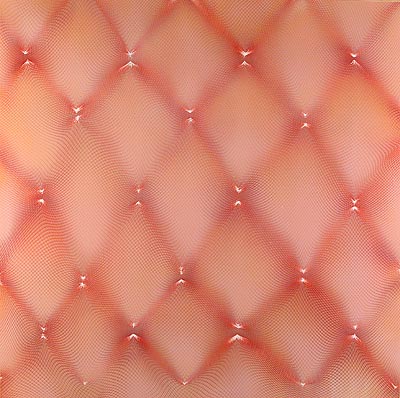 Michelle Hinebrook has a similar painting up; in this case, a dizzying web of pinkness undulates in and out of focus. This is one of those "How did she do that?" kind of paintings -- my guess is spray (airbrush or spraypaint) over folded netting. The layers of darker and lighter colors give this a depth impossible to reproduce here, and the spray pattern is likewise unreproduceably delicate.
Michelle Hinebrook has a similar painting up; in this case, a dizzying web of pinkness undulates in and out of focus. This is one of those "How did she do that?" kind of paintings -- my guess is spray (airbrush or spraypaint) over folded netting. The layers of darker and lighter colors give this a depth impossible to reproduce here, and the spray pattern is likewise unreproduceably delicate.
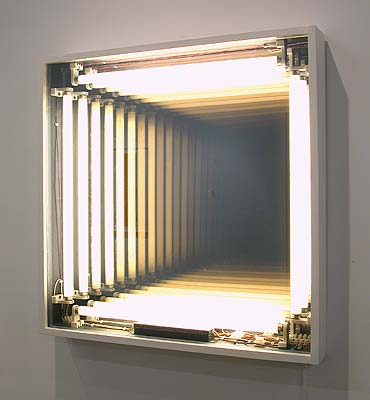 The rest of the show is less interesting but still good and solid. I enjoyed my walk around. The only total dud in the show, I'd say, is Ivan Navarro's Wall Hole, an old idea which looked much better hanging in Mr. Spock's quarters in the fourth Star Trek movie. Only its crudeness makes me think it was intended as something other than what it is; the fact that the light fixtures are so obvious makes me think it might have been intended as some kind of commentary on Spencer's Gifts cheesiness in our society, or something. But, really, I think it's just lame.
The rest of the show is less interesting but still good and solid. I enjoyed my walk around. The only total dud in the show, I'd say, is Ivan Navarro's Wall Hole, an old idea which looked much better hanging in Mr. Spock's quarters in the fourth Star Trek movie. Only its crudeness makes me think it was intended as something other than what it is; the fact that the light fixtures are so obvious makes me think it might have been intended as some kind of commentary on Spencer's Gifts cheesiness in our society, or something. But, really, I think it's just lame.
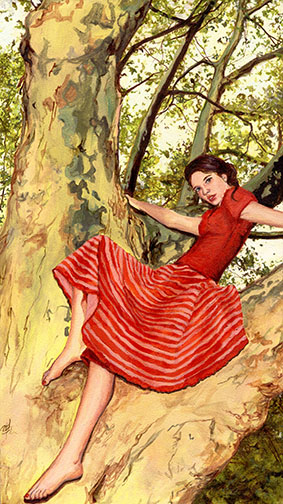 Next door, Lyons Wier-Ortt is showing Amanda Besl. I was surprised to see just how tiny Amanda's paintings are; I'd thought they'd be regular painting-sized paintings but they turned out to be really small, in some cases about the size of an index card. But in that little space Amanda packs a ton of detail and feeling. Her subjects are mostly women (the paintings appear photo-based). The women lounge in the crotches of trees, stand around, sit, sometimes in their underwear, sometimes with veils, in forests, in rooms. Amanda's technique is good but not flawless. There's a detachment in these images, like they were photos taken with a long zoom. The subjects often look directly at the viewer out of the painting, as if making some comment on the nature of viewing. But what, exactly, is unclear to me. Are they happy, are they sad, are they just friends of the artist? They're not quite cheesecake, not quite sexy, not quite asexual -- they're ambiguous. Or maybe they're just too subtle for me. Still, I liked them.
Next door, Lyons Wier-Ortt is showing Amanda Besl. I was surprised to see just how tiny Amanda's paintings are; I'd thought they'd be regular painting-sized paintings but they turned out to be really small, in some cases about the size of an index card. But in that little space Amanda packs a ton of detail and feeling. Her subjects are mostly women (the paintings appear photo-based). The women lounge in the crotches of trees, stand around, sit, sometimes in their underwear, sometimes with veils, in forests, in rooms. Amanda's technique is good but not flawless. There's a detachment in these images, like they were photos taken with a long zoom. The subjects often look directly at the viewer out of the painting, as if making some comment on the nature of viewing. But what, exactly, is unclear to me. Are they happy, are they sad, are they just friends of the artist? They're not quite cheesecake, not quite sexy, not quite asexual -- they're ambiguous. Or maybe they're just too subtle for me. Still, I liked them.
After that Jim and I headed up a block, where we found a huge crowd milling around outside. "Should we fight our way in?" I asked, and Jim assented, and in we went, immediately losing each other when I got caught standing next to Tatum O'Neal while someone took a photo of her. I love her in Rescue Me and in real life she looks exactly the same. I wonder if she's really batshit crazy, too.
When I was able to escape the photo session I found myself in the midst of Jack Pierson's "The name of this show is not GAY ART NOW." Perhaps it isn't, but I'll say this: I don't ordinarily feel exceptionally heterosexual. In most social situations I'm kind of borderline. But in Paul Kasmin Gallery, with that art, with those visitors, I felt like I was...I can't even think of a comparison. Who's the straightest man ever? I felt I was the straightest man ever.
Maybe I'm the most art illiterate person ever, also, since I couldn't place a lot of what was on view. Most of it was forgettable anyway, so I have to apologize to such art luminaries as Matthew Barney, Stephan Tashjian, Robert Indiana, and Elizabeth Peyton: I didn't recognize your work and I didn't care. There really was only one thing in the whole show I slowed down for and I know I've seen the artist before but I couldn't place it. Unfortunately the Paul Kasmin Gallery is so far beyond cool their Website isn't up to date on this show and they had no papers to take from the show itself, so I'm completely devoid of useful information. If I accidentally happen to go back I'll let you know.
I couldn't find Jim anywhere inside so I went outside and around the corner and called him on his cellphone. Now that's a well-attended opening.
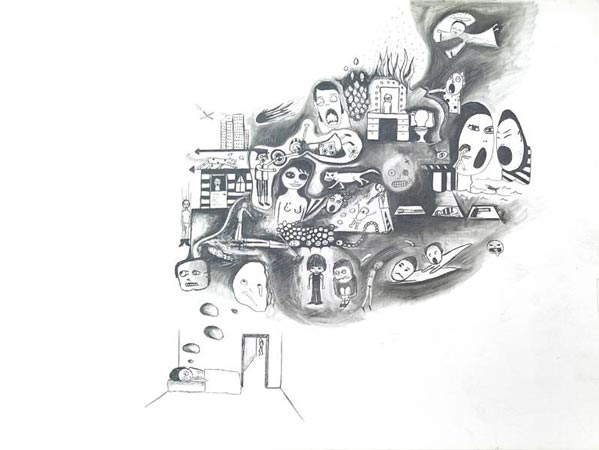 Around the corner at Mixed Greens we made it to see Christina Mazzalupo's drawings. If you've read one of my reviews of shows of drawings before, then you know I'm ambivalent about them: On the one hand I love drawing, but on the other, I still find myself thinking drawings belong in notebooks, not on gallery walls. Christina's work didn't make me change my mind, either. Jim pointed out that all her drawings in the show have the same basic composition, empty in the lower left corner, filled up in the upper right. Now, the show is titled Hey! Get Mental!, so maybe the drawings are all supposed to be dreams, and they all emanate from a dreamer in the lower left corner as a sort of choice of Christina's; but all the same it's a little monotonous.
Around the corner at Mixed Greens we made it to see Christina Mazzalupo's drawings. If you've read one of my reviews of shows of drawings before, then you know I'm ambivalent about them: On the one hand I love drawing, but on the other, I still find myself thinking drawings belong in notebooks, not on gallery walls. Christina's work didn't make me change my mind, either. Jim pointed out that all her drawings in the show have the same basic composition, empty in the lower left corner, filled up in the upper right. Now, the show is titled Hey! Get Mental!, so maybe the drawings are all supposed to be dreams, and they all emanate from a dreamer in the lower left corner as a sort of choice of Christina's; but all the same it's a little monotonous.
The drawings themselves are kind of neat, filled with little details of young girls looking downcast and fantastic animals and religious symbols and, I don't know, UFOs and stuff. After a bit they all kind of blend together. And no wonder: Christina is bipolar, or obsessive-compulsive, or depressed, or all three at once, and I know this because -- in addition to her drawings -- she was giving away little booklets filled with her tiny handwriting telling me all about how crazy she is. It was kind of cute, actually, the sort of booklet we used to put together in college and randomly leave under people's windshield wipers in the parking lot, just a random collection of weirdness. It made me feel very close to Christina (we take a lot of the same medications) and kind of protective of her. It made me want to like her drawings a lot more.
In the end, though, I didn't like them that much. They're okay.
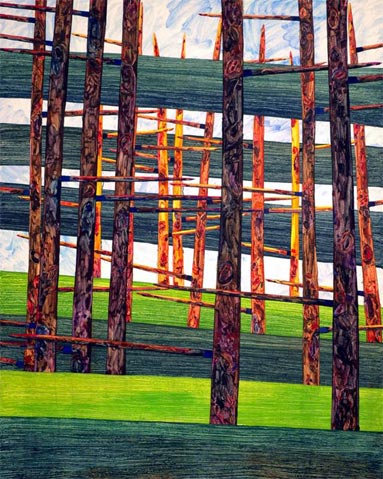 The other side of Mixed Greens is showing Howard Fonda, whose paintings I liked quite a bit. At first glance they look like abstracted stands of trees, but when you look at them a bit longer the illusion breaks down. I like the way Howard disrupts the figure/ground relationship by sometimes having a green stripe (which might be seen as grass behind a tree) or a blue stripe (sky) actually in front of one of the treelike things. Also, I really liked the way the texture of his paint stands in for the detail of the actual object; at first the impression is one of carefully painted nuances, but if you really look, you see his paint is all over the place, scratched back into, goobery, messy. In all, Howard's work is just confounding: As soon as you think you know what it is, it isn't that any more, and it turns into something else. And it does all that with energy and presence. It's actually a little exciting being in front of Howard's paintings.
The other side of Mixed Greens is showing Howard Fonda, whose paintings I liked quite a bit. At first glance they look like abstracted stands of trees, but when you look at them a bit longer the illusion breaks down. I like the way Howard disrupts the figure/ground relationship by sometimes having a green stripe (which might be seen as grass behind a tree) or a blue stripe (sky) actually in front of one of the treelike things. Also, I really liked the way the texture of his paint stands in for the detail of the actual object; at first the impression is one of carefully painted nuances, but if you really look, you see his paint is all over the place, scratched back into, goobery, messy. In all, Howard's work is just confounding: As soon as you think you know what it is, it isn't that any more, and it turns into something else. And it does all that with energy and presence. It's actually a little exciting being in front of Howard's paintings.
While Jim and I were standing in front of Howard's work, Jerry Saltz came up and introduced himself to us. He wanted to tell me he liked my shirt. Jim had just attended a lecture given by Jerry at SVA as part of his residency so we talked about that for a bit. Of course art bloggers in general love to bash Jerry, or pick on him, but every time I've seen him he's struck me as an intelligent, decent person. There's this unnamed art writer and sometime curator who says that's Jerry's thing, populism, man of the people; I don't know if he means that in a bad way, but I don't take it as such. Jerry really seems to be what he seems to be. I certainly wouldn't mind being Jerry Saltz when I grow up.
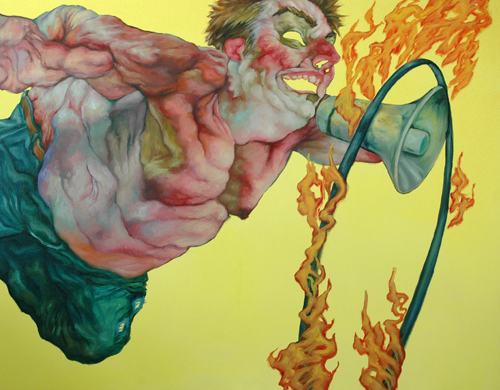 Jim and I eventually moved on to our next and last stop, Chad Marshall at Priska C. Juschka Fine Art. Chad turned out to be perfect for inclusion in an online discussion over at Jason Laning's art soldier: Jason actually liked Dawn Mellor's show, which I of course despised. And I wrote there that there's a difference between a painting which evokes revulsion and one which causes it. Dawn Mellor's works cause revulsion by being themselves revolting and awful; but Chad Marshall's paintings evoke revulsion by being about revolting characters, while being themselves beautiful. In their way. I totally fell in love with Chad's paint handling: It's confident, bold, forward, sweeping, amazing. In the image I've got here, look at the jowls: There's pure, straight blue in there (Jim corrected me at the opening. "Cerulean," he said). No human has that much blue in their skin tone. But hot damn if Chad doesn't pull it off.
Jim and I eventually moved on to our next and last stop, Chad Marshall at Priska C. Juschka Fine Art. Chad turned out to be perfect for inclusion in an online discussion over at Jason Laning's art soldier: Jason actually liked Dawn Mellor's show, which I of course despised. And I wrote there that there's a difference between a painting which evokes revulsion and one which causes it. Dawn Mellor's works cause revulsion by being themselves revolting and awful; but Chad Marshall's paintings evoke revulsion by being about revolting characters, while being themselves beautiful. In their way. I totally fell in love with Chad's paint handling: It's confident, bold, forward, sweeping, amazing. In the image I've got here, look at the jowls: There's pure, straight blue in there (Jim corrected me at the opening. "Cerulean," he said). No human has that much blue in their skin tone. But hot damn if Chad doesn't pull it off.
That said, I didn't for an instant actually like viewing his paintings. They're unpleasant things. Chad likes to show the background color through his figures' orifices, giving everyone the appearance of a rubber mask or suit. Everyone is corpulent and bloated with an air of perversion and sickness. Grotesqueries abound, frolicking and cavorting like happy demons. There's an element of Egon Schiele but taken to another level of disgust for the human form. As usual for me, I'm not sure why -- maybe I'm not supposed to ask. Whatever is going on, it's disturbing.
So I like the technique but not the subject matter. Too bad, really. For me or for Chad? You decide.
I dropped Jim off at Penn Station on my way uptown so he could return to Bon Jovi Land (apparently the "residency" part of "summer residency" is nominal). I'm hoping to get to visit his studio before he's kicked out at the end of June. Here's to hoping.
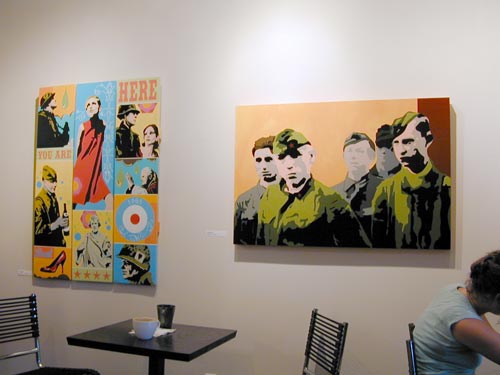 About the worst thing I can say about James' paintings is that they reproduce well. If you've been to
About the worst thing I can say about James' paintings is that they reproduce well. If you've been to 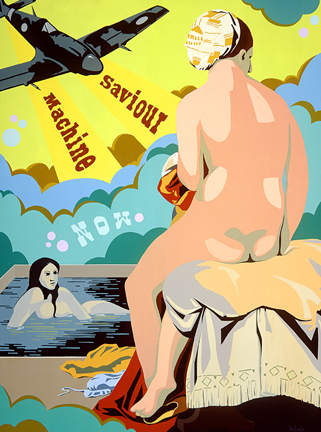 James' paintings are more interesting than Brian's, though. I like them a lot. I've written
James' paintings are more interesting than Brian's, though. I like them a lot. I've written 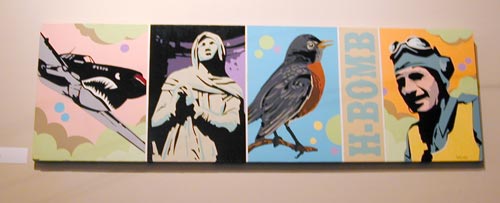 I can't quite figure out what's going on in James' paintings. Are they pro-war, anti-war? Does he like soldiers and warplanes? What's "The New Heaven"? But that's okay. The images themselves carry their own meaning. It seems like they come from James' subconscious and I'm willing to let them seep into mine. His paintings are retinal, as Duchamp would say, but unlike Duchamp, I don't consider that an insult. They please my eye, and I'm good with that.
I can't quite figure out what's going on in James' paintings. Are they pro-war, anti-war? Does he like soldiers and warplanes? What's "The New Heaven"? But that's okay. The images themselves carry their own meaning. It seems like they come from James' subconscious and I'm willing to let them seep into mine. His paintings are retinal, as Duchamp would say, but unlike Duchamp, I don't consider that an insult. They please my eye, and I'm good with that.
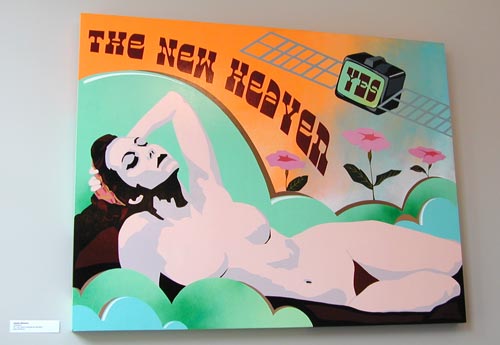 James falls into that category of artist where I think I could physically create his paintings but his ideas are so far beyond me I'm impressed. He makes his actual painting look easy: Stephanie and I
James falls into that category of artist where I think I could physically create his paintings but his ideas are so far beyond me I'm impressed. He makes his actual painting look easy: Stephanie and I 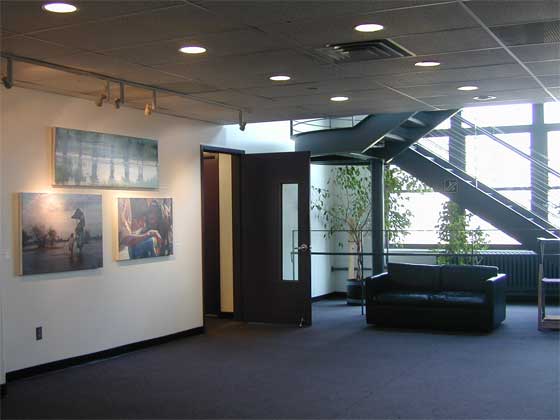 I arrived at the
I arrived at the 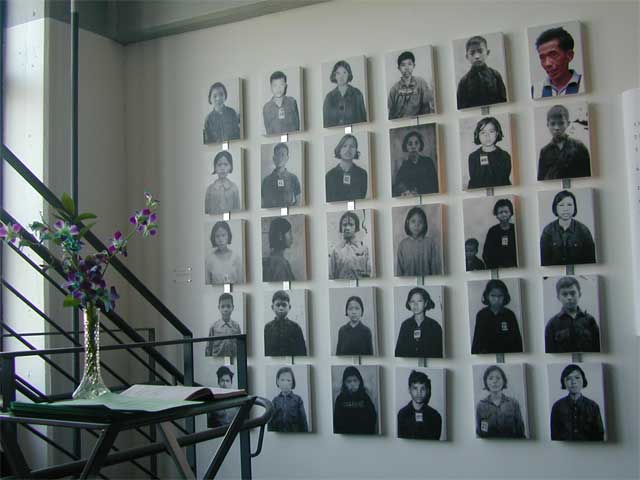 I was most drawn to an arrangement of paintings set up like a photo array. Asians look out at us from poorly developed monochrome photos like mug shots, each wearing a badge with a number pinned to their chest. One woman holds a baby. One woman holds a small child by the hand. There's no defiance, no shows of strength; there's no despair, either, no evidence of hopelessness. There's just the air of an institution, albeit one in great disrepair. Except one color image shows a grinning man in a casual shirt.
I was most drawn to an arrangement of paintings set up like a photo array. Asians look out at us from poorly developed monochrome photos like mug shots, each wearing a badge with a number pinned to their chest. One woman holds a baby. One woman holds a small child by the hand. There's no defiance, no shows of strength; there's no despair, either, no evidence of hopelessness. There's just the air of an institution, albeit one in great disrepair. Except one color image shows a grinning man in a casual shirt.
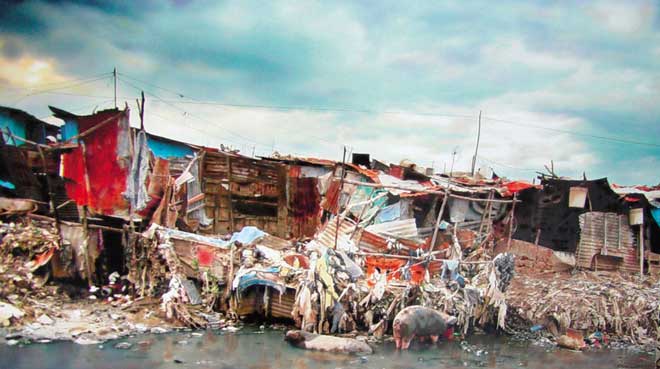
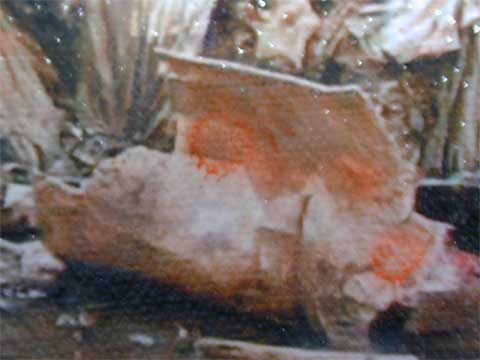 At first glance his paintings seem marvels of precision and in many ways they are. But some of his effects are developed through surprisingly messy work: In one painting there's an almost perfect looking smashed plastic bucket, but if you look very closely you can see a big spray of paint right in the middle of it. You wouldn't think this would work but it does.
At first glance his paintings seem marvels of precision and in many ways they are. But some of his effects are developed through surprisingly messy work: In one painting there's an almost perfect looking smashed plastic bucket, but if you look very closely you can see a big spray of paint right in the middle of it. You wouldn't think this would work but it does.
 Of course it may also be fidelity to his source materials. The photos Denis works from are sometimes heavily compressed and full of digital artifacts, and Denis, when he likes the effect, faithfully reproduces them. It's actually quite amazing. I've worked with digital image formats for years and have a very good eye for picking up certain features, so when I looked at Denis' Journey of a Thousand Nights, I was astonished to see what was clearly JPEG compression artifacts in the background grass. I wouldn't have believed anyone could reproduce them by hand, but Denis has.
Of course it may also be fidelity to his source materials. The photos Denis works from are sometimes heavily compressed and full of digital artifacts, and Denis, when he likes the effect, faithfully reproduces them. It's actually quite amazing. I've worked with digital image formats for years and have a very good eye for picking up certain features, so when I looked at Denis' Journey of a Thousand Nights, I was astonished to see what was clearly JPEG compression artifacts in the background grass. I wouldn't have believed anyone could reproduce them by hand, but Denis has.
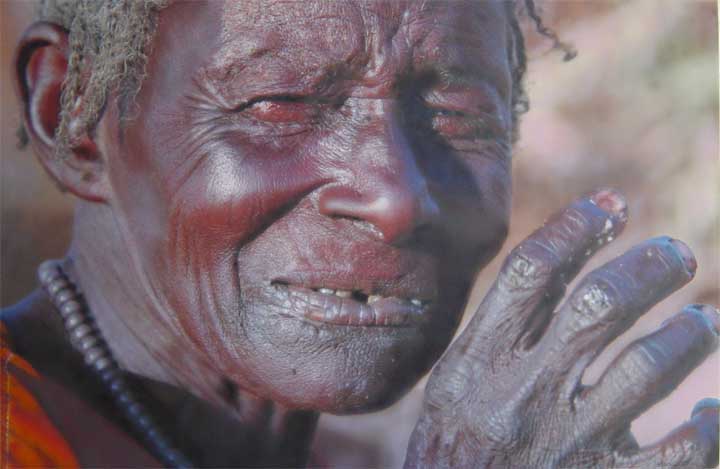 Denis taught me a little about photorealism, too. The photorealists, he told me, only painted as much detail as was needed to get the idea across. They sought the absolute least amount of fine detail which would make a viewer think they were seeing a photo -- and no more. Denis calls his style hyperrealism because he adds more detail than any photo would ever show. In Don't Shed No Tears, for example, he was painting the wrinkles under the woman's eye as he saw them in the photo. And then he added some, thinking, if these are here, why not these?
Denis taught me a little about photorealism, too. The photorealists, he told me, only painted as much detail as was needed to get the idea across. They sought the absolute least amount of fine detail which would make a viewer think they were seeing a photo -- and no more. Denis calls his style hyperrealism because he adds more detail than any photo would ever show. In Don't Shed No Tears, for example, he was painting the wrinkles under the woman's eye as he saw them in the photo. And then he added some, thinking, if these are here, why not these?
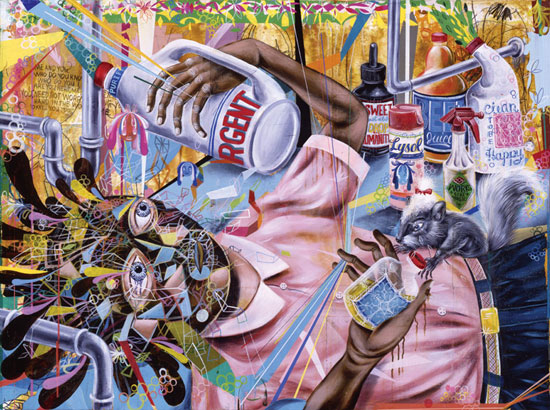 Their current show at Bellwether tackles a very important subject too often ignored by mainstream art: Laundry. The show is titled Wishy Washy, just in case you couldn't tell from all the Pop Art-inspired boxes of Tide and bottles of Clorox and, you know, washing machines. And Lysol, although what Lysol has to do with laundry I am unsure. In case the clothes washing doesn't quite get through to you, though, the little laundromat installation in the middle of the main room will bring it home to you. As usual, I can't tell what the Clayton Brothers really feel; they seem angry, as I said, but in a very non-specific way. I don't think they're angry at people who do laundry, but maybe they're mad about the very fact that anyone has to do laundry; I find their paintings totally opaque. Everything seems weighted with some kind of symbolism but the meaning is unclear to me. And as the great sage Roger Ebert teaches us in his Law of Symbolism: If you have to ask what something symbolized, it didn't. What are we to make, for example, of the numerous squirting eyedroppers being wielded in several of the paintings? The obvious thing is to say they're phallic symbols. But then what? Whose phalluses? Why?
Their current show at Bellwether tackles a very important subject too often ignored by mainstream art: Laundry. The show is titled Wishy Washy, just in case you couldn't tell from all the Pop Art-inspired boxes of Tide and bottles of Clorox and, you know, washing machines. And Lysol, although what Lysol has to do with laundry I am unsure. In case the clothes washing doesn't quite get through to you, though, the little laundromat installation in the middle of the main room will bring it home to you. As usual, I can't tell what the Clayton Brothers really feel; they seem angry, as I said, but in a very non-specific way. I don't think they're angry at people who do laundry, but maybe they're mad about the very fact that anyone has to do laundry; I find their paintings totally opaque. Everything seems weighted with some kind of symbolism but the meaning is unclear to me. And as the great sage Roger Ebert teaches us in his Law of Symbolism: If you have to ask what something symbolized, it didn't. What are we to make, for example, of the numerous squirting eyedroppers being wielded in several of the paintings? The obvious thing is to say they're phallic symbols. But then what? Whose phalluses? Why?
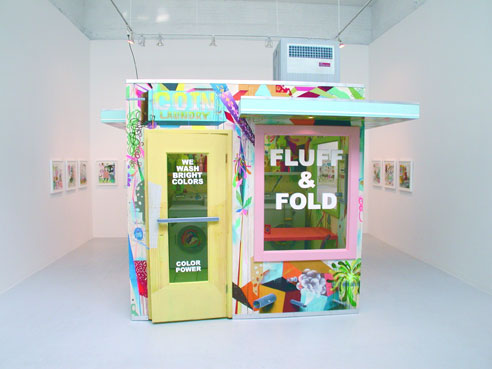 The laundromat installation is completely superfluous. I don't know if it's there to pad their resume or maintain some kind of Conceptual Artist membership, but it's not especially interesting, except in bringing up those practical questions I love to ask: Does the gallery give the artist a budget for this kind of thing, or does the artist save up to pay for it themselves? Where does it go when the show is over? Are there collectors who buy these things and put them in their living rooms? Stephanie said it was very nearly a rip-off of another artist who apparently does these kinds of things all the time; I forget the name. It doesn't really matter to me. I don't think it's worth attempting to assign blame for installations.
The laundromat installation is completely superfluous. I don't know if it's there to pad their resume or maintain some kind of Conceptual Artist membership, but it's not especially interesting, except in bringing up those practical questions I love to ask: Does the gallery give the artist a budget for this kind of thing, or does the artist save up to pay for it themselves? Where does it go when the show is over? Are there collectors who buy these things and put them in their living rooms? Stephanie said it was very nearly a rip-off of another artist who apparently does these kinds of things all the time; I forget the name. It doesn't really matter to me. I don't think it's worth attempting to assign blame for installations.
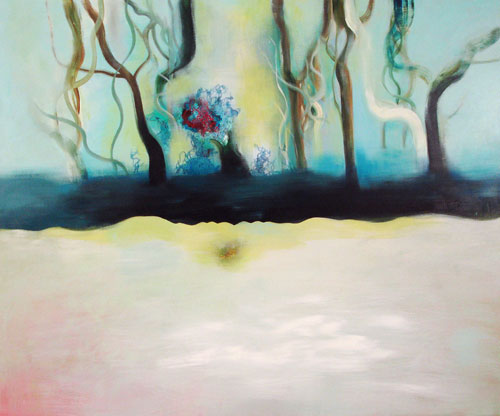 But this is why I follow recommendations: I was pleasantly surprised. I found I actually do like Jennifer's work. I think the show's signature image, Two Trees -- apparently her latest painting, and the one you can see on Ed's blog entry -- is the weakest of the group; she has two larger paintings which work much better, to my eye. Each painting in this show combines vast sweeps of color with tiny, obsessive passages of great detail. And each one has vague intimations of landscape. Two Trees is the most obvious and that, to me, is a drawback. I prefer her Creeper, which has subtleties you can't make out in the reproduction: The middle section looks like an eruption of worms, boiling out of the filmy atmosphere of the place-no-place of the painting.
But this is why I follow recommendations: I was pleasantly surprised. I found I actually do like Jennifer's work. I think the show's signature image, Two Trees -- apparently her latest painting, and the one you can see on Ed's blog entry -- is the weakest of the group; she has two larger paintings which work much better, to my eye. Each painting in this show combines vast sweeps of color with tiny, obsessive passages of great detail. And each one has vague intimations of landscape. Two Trees is the most obvious and that, to me, is a drawback. I prefer her Creeper, which has subtleties you can't make out in the reproduction: The middle section looks like an eruption of worms, boiling out of the filmy atmosphere of the place-no-place of the painting.
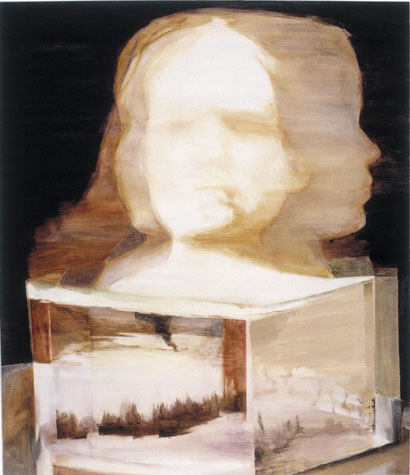 Susanne Simonson's work has the feel of a dream, in that you think there's more detail there than there really is. At a glance there's something photographic about her paintings, but when you really look, it turns out to be vague and amorphous. Some of the paint is laid on very thickly and stickily; other areas look almost like watercolors. The feeling I got was a touch of Francis Bacon, only without the anger; Bacon without anger doesn't leave much, though, and that's how I felt. There are some distant vibrations here -- puberty, childhood, being a young girl, uneasiness -- but everything is so vaporous, tentative, and indefinite; I felt like my hands were closing on smoke.
Susanne Simonson's work has the feel of a dream, in that you think there's more detail there than there really is. At a glance there's something photographic about her paintings, but when you really look, it turns out to be vague and amorphous. Some of the paint is laid on very thickly and stickily; other areas look almost like watercolors. The feeling I got was a touch of Francis Bacon, only without the anger; Bacon without anger doesn't leave much, though, and that's how I felt. There are some distant vibrations here -- puberty, childhood, being a young girl, uneasiness -- but everything is so vaporous, tentative, and indefinite; I felt like my hands were closing on smoke.
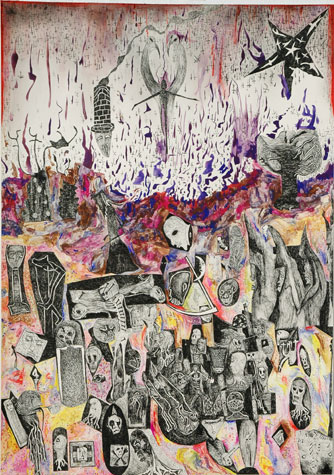
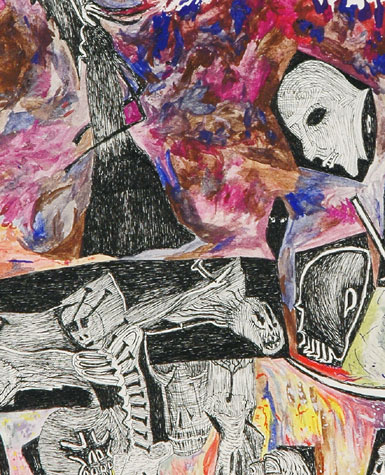 By contrast, the drawings of Nick Blinko, hiding in the back of Feigen, are intensely detailed and frenzied. And where Susanne's paintings are ambiguous, Nick's drawings are pretty clear. I guess you can't just write "RELIGION BAD" over and over, but Nick's heavy-handed use of religious imagery is close. Still, as I've mentioned more than once, I love obsessive drawing, and these drawings are pretty insanely obsessive. If ever there was someone who could wear out a 0.13mm Rapidograph, it's Nick Blinko. A couple of the drawings had so many tiny faces I had to stop looking because my brain was full. Sure, they look a little like the schoolbook of a Mexican Goth in Catholic school with ADHD, but that's not such a bad thing.
By contrast, the drawings of Nick Blinko, hiding in the back of Feigen, are intensely detailed and frenzied. And where Susanne's paintings are ambiguous, Nick's drawings are pretty clear. I guess you can't just write "RELIGION BAD" over and over, but Nick's heavy-handed use of religious imagery is close. Still, as I've mentioned more than once, I love obsessive drawing, and these drawings are pretty insanely obsessive. If ever there was someone who could wear out a 0.13mm Rapidograph, it's Nick Blinko. A couple of the drawings had so many tiny faces I had to stop looking because my brain was full. Sure, they look a little like the schoolbook of a Mexican Goth in Catholic school with ADHD, but that's not such a bad thing.
 I wish someone would break up this diptych. The left side is pretty good: An artist (I assume Nicole) is surrounded by pressures and influences, including painted and unpainted pieces of canvas added collage-like to the surface of the larger painting and a big globby mess of paint meant to symbolize, I'm pretty sure, a big globby mess of paint. There's a lot of detail, some abstract passages and some realistic; there's plenty to look at and think about. Nicole's technique is good and I was drawn in.
I wish someone would break up this diptych. The left side is pretty good: An artist (I assume Nicole) is surrounded by pressures and influences, including painted and unpainted pieces of canvas added collage-like to the surface of the larger painting and a big globby mess of paint meant to symbolize, I'm pretty sure, a big globby mess of paint. There's a lot of detail, some abstract passages and some realistic; there's plenty to look at and think about. Nicole's technique is good and I was drawn in.
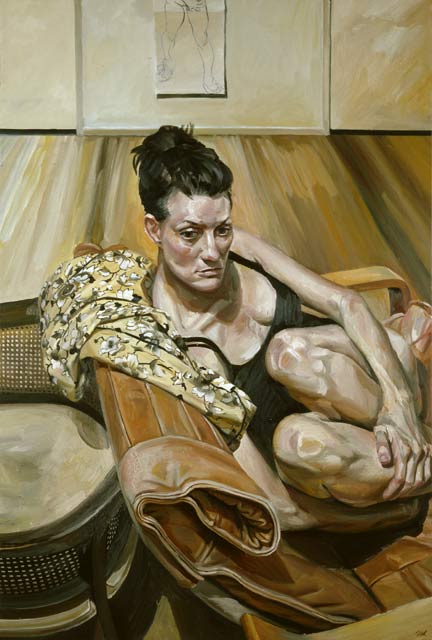 Eventually we made our way upstairs and to the main gallery. Stephen Wright's work is absolutely fantastic. Some of his larger figurative work (like what I'm showing here) is edging towards Lucian Freud, but with a little more humanity. Some of his other paintings are flatter and less dense. Sometimes it looks like he's working from photos; other times he's so painterly it's almost frightening. All of his work feels a little detached, as if he's capturing what someone looks like whether they like it or not. But his feel for skin and light and shadow is so emotional.
Eventually we made our way upstairs and to the main gallery. Stephen Wright's work is absolutely fantastic. Some of his larger figurative work (like what I'm showing here) is edging towards Lucian Freud, but with a little more humanity. Some of his other paintings are flatter and less dense. Sometimes it looks like he's working from photos; other times he's so painterly it's almost frightening. All of his work feels a little detached, as if he's capturing what someone looks like whether they like it or not. But his feel for skin and light and shadow is so emotional.
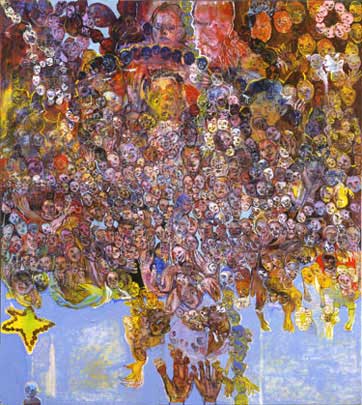 I'm sorry to say that
I'm sorry to say that 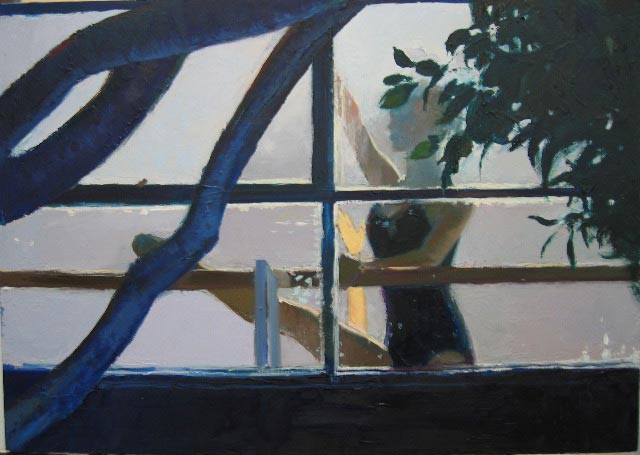 I'm not sure now what made me want to see
I'm not sure now what made me want to see 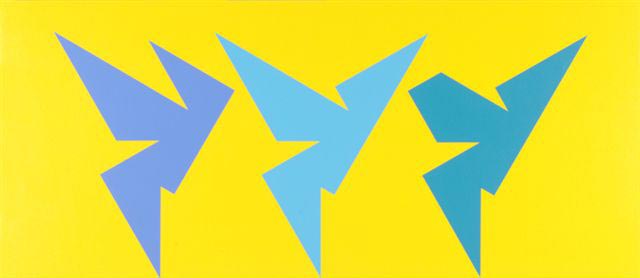 "You know, sometimes I think it'd be so nice," Stephanie said, upon viewing
"You know, sometimes I think it'd be so nice," Stephanie said, upon viewing 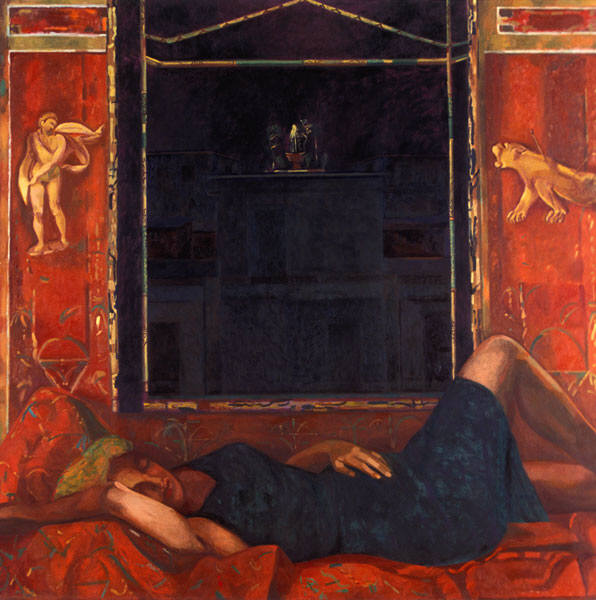
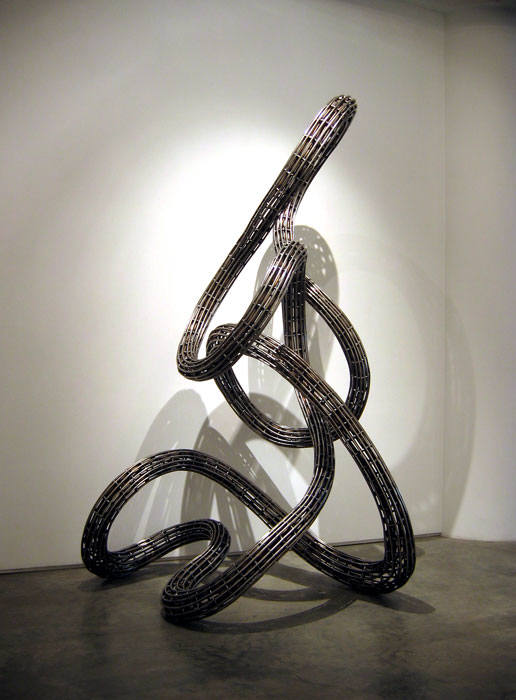
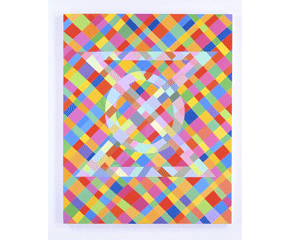 at
at 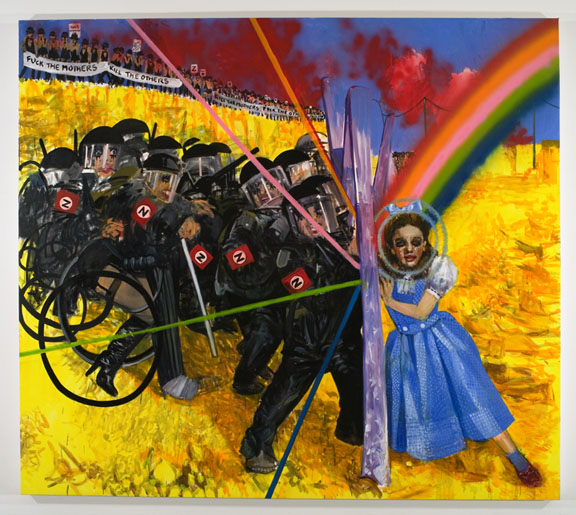 Dawn's paintings are just plain ugly. Nasty, stupid, shallow, worthless -- even to compare these paintings to crap would be unfair to crap, which after all has its uses. One denizen of a painting had a fistful of paintbrushes shoved up their ass, and I honestly can't find a better metaphor for what I thought of these works. I want to put the word "art" in quotes when discussing them. They're hateful and awful. Now, you might be saying, but Chris, the name of the show is We Hope You Choke. What were you expecting? Good question.
Dawn's paintings are just plain ugly. Nasty, stupid, shallow, worthless -- even to compare these paintings to crap would be unfair to crap, which after all has its uses. One denizen of a painting had a fistful of paintbrushes shoved up their ass, and I honestly can't find a better metaphor for what I thought of these works. I want to put the word "art" in quotes when discussing them. They're hateful and awful. Now, you might be saying, but Chris, the name of the show is We Hope You Choke. What were you expecting? Good question.

